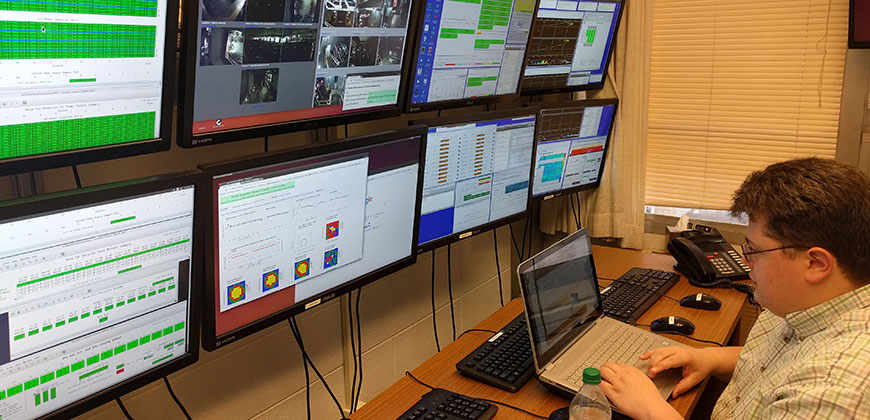
Physics graduate student Paul Rojas monitors the NOvA experiment from CSU’s Remote Operations Center, located in the Physics Building.
The Physics Building hallways were quiet the afternoon of Dec. 19 – but not for graduate student Paul Rojas.
Holed up in a first-floor room with 12 flashing computer screens, Rojas spent most of that week keeping watch over an international, multi-hundred million dollar physics experiment that, once complete, could turn decades of physics on its head and solve profound mysteries of the universe’s origins.
Rojas and his adviser, physics Associate Professor Norman Buchanan, work on NOvA, an international physics collaboration that began in 2014, based at Fermi National Accelerator Laboratory (Fermilab). The goal of NOvA is to explore neutrinos – subatomic particles that are among the most abundant in the universe, but also some of the most difficult to make and observe. Understanding everything about neutrinos could tell us why the universe is made mostly of matter, when theory tells us it should be composed of equal parts of something else called antimatter.
Twenty-four hours a day, 365 days a year, at least one specially trained NOvA collaboration member is assigned to keep watch over scientific operations of the multi-layered experiment that involves hundreds of scientists. And thanks to the wonders of modern technology, this mission-critical monitoring can be done remotely.
“It’s sort of amazing that you can sit down and take control of an experiment of this value, and run it remotely,” Buchanan said.
Mission control, Fort Collins
CSU’s Remote Operations Center (ROC) for NOvA is one of only 12 in the world. It was the eighth to come online, and it was the upstart brainchild of Buchanan, who works on one of NOvA’s neutrino detectors that analyzes both neutrinos and antineutrinos. Buchanan also leads efforts around what’s called non-beam physics, such as neutrinos from supernovae, or dying stars. The NOvA experiment, even when not making its own neutrinos, is constantly on the lookout for neutrinos from supernovae, or from cosmic rays hitting Earth.
Rojas is a member of Buchanan’s CSU team, along with graduate student Matt Judah and postdoctoral associate Shih-Kai Lin, both of whom work physically at Fermilab. Every member of Buchanan’s CSU NOvA team takes ROC shifts, including Buchanan himself.
“These are complicated systems – it’s not like a GM truck where you turn it on and everything just works,” Buchanan said. “This is cutting-edge technology, and to make sure everything is working correctly requires someone sitting in a room, looking at diagnostics. If we notice one of the detectors doing something we don’t expect to see, we let the experts know, and they can repair it.”
The afternoon of Dec. 19, all was quiet in the CSU ROC, as Rojas kept vigil over readings of temperature, voltage, beam profile and security cameras. “We want it to be quiet,” said Rojas, who was set to pull four consecutive eight-hour shifts (with breaks for sleep). Unlike in the movies, where operations centers like CSU’s are the first places some anomaly or menace is detected (think beeping screens and red alerts), a quiet shift is a good shift.
Buchanan applied for CSU to become a NOvA ROC in late 2015. He and his students were traveling back and forth to Fermilab to do shifts. By setting up a ROC, not only could they offer NOvA expertise and help, they could also save CSU money and travel time. Buchanan raised the approximately $10,000 to create and maintain the ROC, with support from the Department of Energy, the physics department and the Office of the Vice President for Research. The CSU ROC became operational this past spring, and since then Buchanan’s team has performed several shifts from mission control in Fort Collins.
Neutrinos and what they could tell us
NOvA is a particle physics experiment, in which a beam of protons is accelerated to nearly the speed of light, and is periodically crashed into a carbon target. Two detectors – called the near and far – track the spray of resulting particles. Every now and again, those particles decay into neutrinos. And when those neutrinos interact with the detectors, the scientists watch their every move. The experiment records terabytes of data a day from its detectors.
Among the most fundamental questions that NOvA might answer: Where’s the antimatter? That is, the universe is made mostly of matter, but theory tells us that there should be just as much antimatter, and that these parts should behave equally. This theoretical equal behavior is called charge-parity symmetry.
But matter and antimatter, it turns out, are not mirror images. The reason may be that neutrinos, at some point in the formation of the universe, tipped that balance. The scientists working on NOvA, as well as other neutrino experiments like T2K in Japan, want to detect a definitive violation of charge parity symmetry. The same mechanism that makes neutrinos and their equal, oppositely charged particles, antineutrinos, act differently could lend insight into why matter and antimatter seem to have behaved differently in the distant past. This neutrino-antineutrino asymmetry, if demonstrated, could explain why there’s so much more matter than antimatter around us.
In other words, neutrinos could explain the structure of the universe. To be part of such a quest, what’s a few late-night shifts?